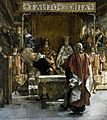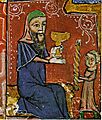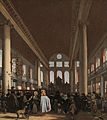Sephardi Jews facts for kids
| Total population | |
|---|---|
| 2,200,000 up to 16% of world Jewish population |
|
| Regions with significant populations | |
| 1.4 million | |
| 300,000–400,000 | |
| 200,000–300,000 | |
| 50,000 | |
| 40,000 | |
| 30,000 | |
| 26,000 | |
| 24,930 | |
| 15,000 | |
| 8,000 | |
| 8,000 | |
| 7,000 | |
| 6,000 | |
| 6,000 | |
| 2,000 | |
| 2,000 | |
| 2,000 | |
| 1,500 | |
| 1,000 | |
| 600 | |
| 200 | |
| Languages | |
| Historical: Ladino, Arabic (Andalusian), Haketia, Judeo-Portuguese, Berber, Catalanic, Shuadit, local languages Modern: Local languages, primarily Modern Hebrew, French, English, Turkish, Spanish, Portuguese, Italian, Ladino, Arabic. |
|
| Religion | |
| Judaism | |
| Related ethnic groups | |
| Ashkenazi Jews, Mizrahi Jews, other Jewish ethnic divisions, Samaritans, other Levantines, Lebanese, Syrians, other Near Eastern Semitic people, Spaniards, Portuguese and Hispanics/Latinos | |
Sephardi Jews, also called Sephardim, are a group of Jewish people with a special history. Their name comes from "Sepharad," which is the Hebrew word for Spain. This group of Jews first formed around the year 1000 AD on the Iberian Peninsula, which includes modern-day Spain and Portugal.
For many centuries, Jewish communities thrived in Spain and Portugal. However, in the late 1400s, all Jews were asked to leave Spain. This event is known as the expulsion. After this, Sephardi Jews moved to many new places. They settled in countries like England, the Netherlands, North Africa, Turkey, the Eastern Mediterranean, the Balkans, and the Americas. In these new homes, they worked hard to keep their unique traditions and religious practices alive. For hundreds of years, many Sephardi Jews continued to speak their special language, Ladino, alongside the language of the country they lived in.
Contents
Where Did Sephardi Jews Come From?
The story of Sephardi Jews begins in the Iberian Peninsula. This is the land where Spain and Portugal are today. Jewish people had lived there for a very long time, even before the year 1000 AD. They built strong communities and contributed a lot to the culture and knowledge of the region.
Life in Medieval Spain
During the Middle Ages, especially in a part of Spain called Al-Andalus, Jewish people lived alongside Muslims and Christians. This time was often called a "Golden Age" for Jewish culture. They made big advancements in science, philosophy, medicine, and poetry. Many famous Jewish thinkers, like the rabbi and philosopher Maimonides, came from this period. They helped to share knowledge and ideas across different cultures.
Moving to New Homes
In 1492, a very important event happened. The rulers of Spain decided that all Jews had to leave the country. This was a difficult time for the Sephardi Jews. They had to leave their homes and everything they knew. Many of them moved to Portugal, but soon after, they were also forced to leave there.
Spreading Across the World
After leaving Spain and Portugal, Sephardi Jews traveled to many different parts of the world.
- Some went to other countries in Europe, like the Netherlands and England.
- Many moved to lands controlled by the Ottoman Empire, such as Turkey, Greece, and countries in the Balkans.
- Others settled in North Africa and the Middle East.
- Later, some even traveled across the ocean to the Americas.
No matter where they went, they carried their traditions, their language, and their unique way of life with them. They built new synagogues and communities, keeping their heritage strong.
Their Special Language: Ladino
One of the most unique parts of Sephardi culture is the Ladino language. It is also known as Judeo-Spanish. Ladino is a mix of old Spanish, with words from Hebrew, Arabic, Turkish, and other languages. It was the everyday language for many Sephardi Jews for centuries.
Keeping Ladino Alive
Even though Sephardi Jews moved to many different countries, they continued to speak Ladino. They used it in their homes, in their prayers, and for writing books and newspapers. Today, fewer people speak Ladino as their main language, but there are still efforts to teach it and keep it alive. It is an important part of their history and identity.
Sephardi Jews Around the World Today
Today, Sephardi Jews live all over the globe. The largest population is in Israel, but there are also big communities in France, the United States, and many other countries. They continue to practice Judaism and celebrate their unique heritage. While they have adapted to modern life, they still value their history and the traditions passed down through generations.
Related pages
Images for kids
-
Statue of the Sephardic rabbi and philosopher Maimonides, in Córdoba, Spain
-
Jewish Festival in Tetuan, Alfred Dehodencq, 1865, Paris Museum of Jewish Art and History
-
Sephardi Jewish couple from Sarajevo in traditional clothing (1900)
-
A 1902 Issue of La Epoca, a Ladino newspaper from Salonica (Thessaloniki)
-
First Cemetery of the Spanish and Portuguese Synagogue, Shearith Israel (1656–1833) in Manhattan, New York City
-
Emma Lazarus, American poet. Born into a large New York Sephardi family.
-
The Expulsion of the Jews from Spain (in the year 1492) by Emilio Sala Francés
-
Dedication at Yad Vashem in Jerusalem written in Hebrew, English, Yiddish, and Judeo-Spanish
-
13th-century depiction of a Jew and Muslim playing chess in Al-Andalus
-
A young woman weeps during the deportation of Jews of Ioannina (Greece) on 25 March 1944.
See also
 In Spanish: Sefardí para niños
In Spanish: Sefardí para niños















